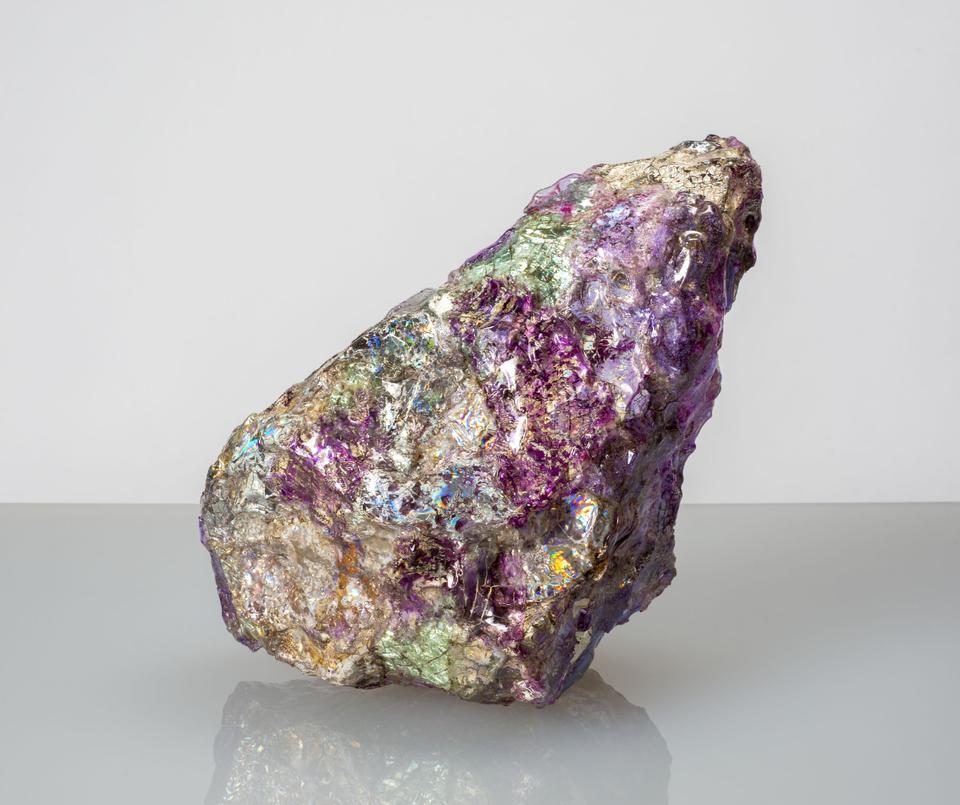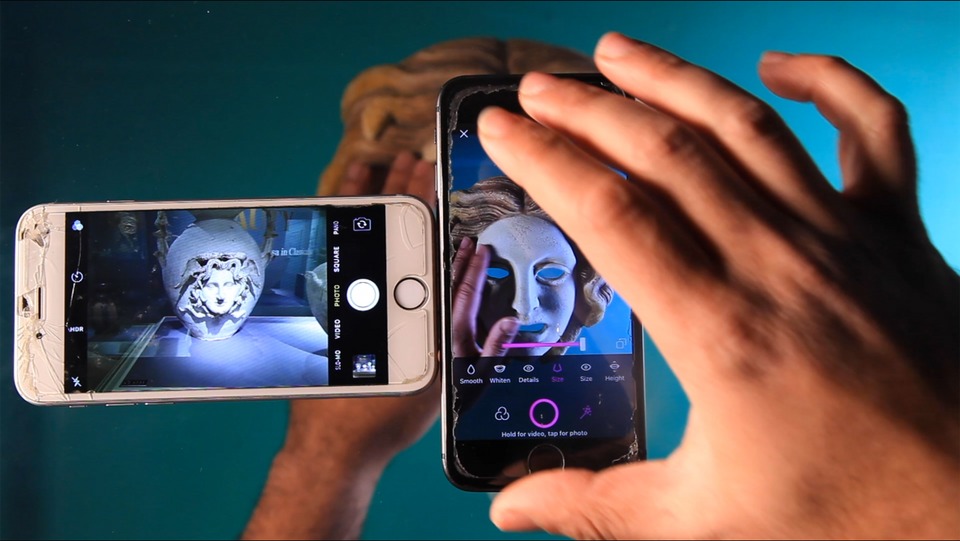Pera Museum’s newest exhibition, Crystal Clear, is open to the public on site, and will be on view until March 7, 2021 in Istanbul’s Beyoglu district.
“‘Crystal Clear’ is an exhibition we started planning about two years ago; that is to say, before the global pandemic took over our lives,” the General Manager of Suna and Inan Kirac Foundation, Culture and Art Enterprises Ozalp Birol says.
“The exhibition slowly evolved from its origins into a different animal, into an interesting project,” Birol adds. “At first, it was supposed to be a project that artists would question clarity, opacity, earth and growth, within the axis of the Mineral Museum in Paris with our curator Elena Sorokina.”
Admitting that attendance had dropped considerably, Birol says the pandemic changed their plans as Pera Museum closed in March 2020 and reopened in June 2020 — “despite all the difficulties that we experienced, we did not cancel the exhibition.”
“The pandemic changed many questions asked [by the artists]; it led us to new perspectives and new ways of looking. The Crystal Clear exhibition gave the artists new concepts to play with that appeared during this process, leading them to create more timely and interesting pieces.”

Gunes Terkol, The Dictionary of Distance, 2020. Installation of 21 gauze textiles. Variable dimensions. (Courtesy of Pera Museum)
In an essay titled ‘Seeing the Pandemic in a Crystal Ball’, the curator, Elena Sorokina, writes that “What did eventually crystallise during the lockdown? I decided to slow down the process and to give the artists more time to think about new work. I could have changed directions, could have added new questions, shifted the angle, and got rid of the crystals all together. And yet crystals proved a fruitful subject, allowing the artists to translate their thoughts into forms, to trace back to relevant histories and to put forward all the ambiguities between living and non-living, organic and non-organic matter. Furthermore, they provided excellent examples for optical effects and fascinating cases of transparency and translucency.”
In an essay titled ‘Seeing the Pandemic in a Crystal Ball’, the curator, Elena Sorokina, writes that “What did eventually crystallise during the lockdown? I decided to slow down the process and to give the artists more time to think about new work. I could have changed directions, could have added new questions, shifted the angle, and got rid of the crystals all together. And yet crystals proved a fruitful subject, allowing the artists to translate their thoughts into forms, to trace back to relevant histories and to put forward all the ambiguities between living and non-living, organic and non-organic matter. Furthermore, they provided excellent examples for optical effects and fascinating cases of transparency and translucency.”

Kiymet Dasdan, I Am Afraid To (Not) Forget, 2019. Oblivion Stones series,
2019-2020. Optical media. Dimensions variable. (Courtesy of Pera Museum)
Sorokina cites two main reference texts that she and the artists relied on: One was Bruno Latour’s essay What Protective Measures Can You Think of So We Don’t Go Back to the Pre-Crisis Production Model? “Written in the midst of the lockdown, the text poses questions about how to evaluate universal suspension of the economic system and how to use this situation for ecological change.”
The second text was Byung-Chul Han’s book The Transparency Society. “Published in 2012 it analyses global transparency as one of the strongest of our contemporary mythologies. Today anyone can obtain information about anything. Everything — and everyone — has become transparent, unveiled and exposed. Yet transparency has its dark side and can turn into opacity, without us even noticing it. Unfolding this question, Han analyses exposure and evidence, intimacy and revelation; and the most important issue derived from transparency: control.”
Sorokina cites two main reference texts that she and the artists relied on: One was Bruno Latour’s essay What Protective Measures Can You Think of So We Don’t Go Back to the Pre-Crisis Production Model? “Written in the midst of the lockdown, the text poses questions about how to evaluate universal suspension of the economic system and how to use this situation for ecological change.”
The second text was Byung-Chul Han’s book The Transparency Society. “Published in 2012 it analyses global transparency as one of the strongest of our contemporary mythologies. Today anyone can obtain information about anything. Everything — and everyone — has become transparent, unveiled and exposed. Yet transparency has its dark side and can turn into opacity, without us even noticing it. Unfolding this question, Han analyses exposure and evidence, intimacy and revelation; and the most important issue derived from transparency: control.”

Yazan Khalili, Medusa: Don’t be a stranger, 2020. Video installation.
(Courtesy of Pera Museum)
While the single-floor exhibition has its purely aesthetically pleasing moments, such as the crystals formed from old CDs surrounded by magnifying glasses –– all the better to observe them with –– (by Kiymet Dastan), viewers are recommended to read the labels, spend some time going beyond the surface of the materials presented to them, and to consider what the artists were trying to communicate rather than just to walk through the exhibit at a high clip.
“Crystal Clear” features work by Sammy Baloji, Minia Biabiany, Katinka Bock, Bianca Bondi, Gaelle Choisne, Kiymet Dastan, Elmas Deniz, Sinem Disli, Gluklya (Natalia Pershina-Yakimanskaya), Deniz Gul, Ilana Halperin, Gulsun Karamustafa, Yazan Khalili, Paul Maheke, Sener Ozmen, Iz Oztat, Hale Tenger, Gunes Terkol, Berkay Tuncay and Adrien Vescovi.
While the single-floor exhibition has its purely aesthetically pleasing moments, such as the crystals formed from old CDs surrounded by magnifying glasses –– all the better to observe them with –– (by Kiymet Dastan), viewers are recommended to read the labels, spend some time going beyond the surface of the materials presented to them, and to consider what the artists were trying to communicate rather than just to walk through the exhibit at a high clip.
“Crystal Clear” features work by Sammy Baloji, Minia Biabiany, Katinka Bock, Bianca Bondi, Gaelle Choisne, Kiymet Dastan, Elmas Deniz, Sinem Disli, Gluklya (Natalia Pershina-Yakimanskaya), Deniz Gul, Ilana Halperin, Gulsun Karamustafa, Yazan Khalili, Paul Maheke, Sener Ozmen, Iz Oztat, Hale Tenger, Gunes Terkol, Berkay Tuncay and Adrien Vescovi.

Katinka Bock, Possible Confusions, 2020. Coppersmiths: Selami Zan, Nejat Kilic. Tailors: Tulug Unluturk, Celalettin Benli. Fabric, PVC, copper, poem. Dimensions variable. (Courtesy of Pera Museum)
The artworks range from digital video (a commentary on facial recognition software featuring the Greek ‘villain’ Medusa, by Yazan Khalili, and Gulsun Karamustafa’s cabinet of curiosities explored by a child with nail polished hands) to textiles (a lament on a black man drowning in a canal in Venice by Paul Maheke, as well as Ilana Halperin’s collaboration with Knitstanbul, called ‘Our Hands Enact the Geologic Process I-V’, not to mention Gunes Terkol’s gauze textiles prepared during the pandemic), from shells and needlepoint lace accompanying a seaside video (Elmas Deniz) to lead (Sener Ozmen, in a reference to the Middle Eastern practice of pouring lead to exorcise bad spirits and to tell fortunes). There are also works on paper, photographs, soil and sulphur.
The colourful and wide-ranging exhibit will surely result in a thought-provoking afternoon for art lovers who visit the Pera Museum. The museum is open Tuesday to Saturday 11 am to 6 pm and Sunday 12 noon to 6 pm. Entrance is free of charge for all visitors on Friday between 4 pm and 6 pm. Students can visit for free on ‘Young Wednesdays’.
Thumbnail photo: Paul Maheke, The River Asked for a Kiss (To Pateh Sabally), 2017. 4 digitally printed curtains. Courtesy of Pera Museum.
Headline photo: Elmas Deniz, A Tale of the Earth, 2020. Installation. Acid-free bookbinding fabric, cardboard, wooden frame, glass, stones, needlepoint lace, light box, pencil drawings, text, leaves, frames, shells, LED lights, gold, fabric. Courtesy of Pera Museum.
The artworks range from digital video (a commentary on facial recognition software featuring the Greek ‘villain’ Medusa, by Yazan Khalili, and Gulsun Karamustafa’s cabinet of curiosities explored by a child with nail polished hands) to textiles (a lament on a black man drowning in a canal in Venice by Paul Maheke, as well as Ilana Halperin’s collaboration with Knitstanbul, called ‘Our Hands Enact the Geologic Process I-V’, not to mention Gunes Terkol’s gauze textiles prepared during the pandemic), from shells and needlepoint lace accompanying a seaside video (Elmas Deniz) to lead (Sener Ozmen, in a reference to the Middle Eastern practice of pouring lead to exorcise bad spirits and to tell fortunes). There are also works on paper, photographs, soil and sulphur.
The colourful and wide-ranging exhibit will surely result in a thought-provoking afternoon for art lovers who visit the Pera Museum. The museum is open Tuesday to Saturday 11 am to 6 pm and Sunday 12 noon to 6 pm. Entrance is free of charge for all visitors on Friday between 4 pm and 6 pm. Students can visit for free on ‘Young Wednesdays’.
Thumbnail photo: Paul Maheke, The River Asked for a Kiss (To Pateh Sabally), 2017. 4 digitally printed curtains. Courtesy of Pera Museum.
Headline photo: Elmas Deniz, A Tale of the Earth, 2020. Installation. Acid-free bookbinding fabric, cardboard, wooden frame, glass, stones, needlepoint lace, light box, pencil drawings, text, leaves, frames, shells, LED lights, gold, fabric. Courtesy of Pera Museum.
Source: TRT World
No comments:
Post a Comment